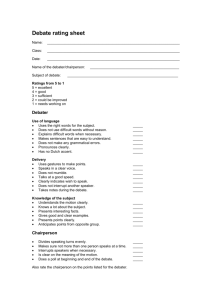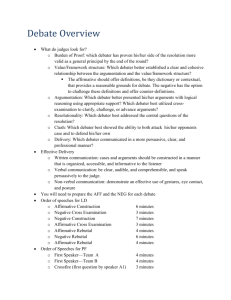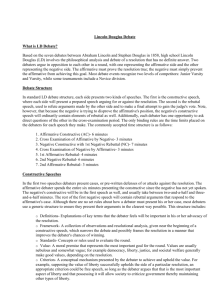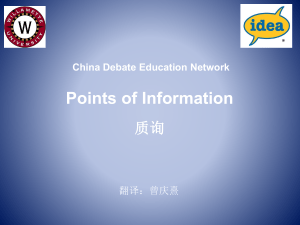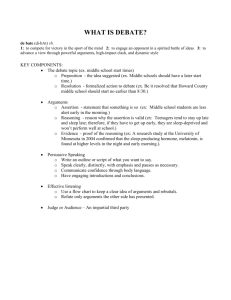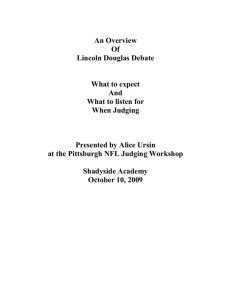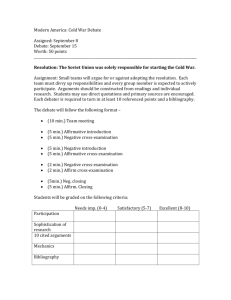1ST DACET-INTERSCHOOL DEBATE RULES MODIFIED OXFORD
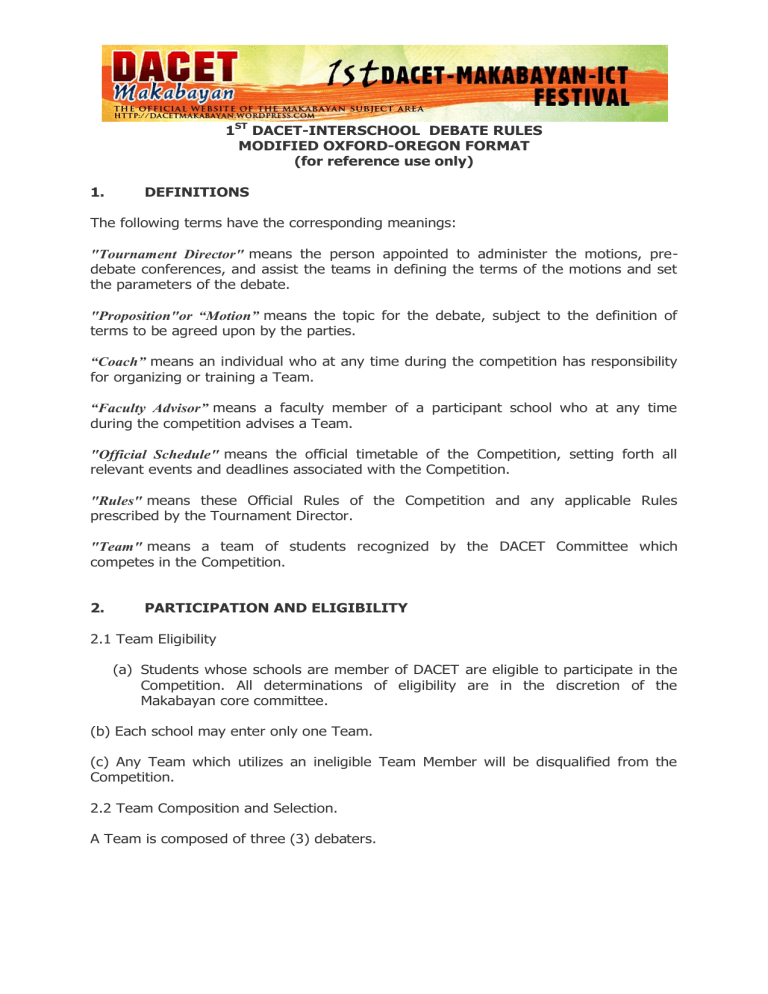
1 ST DACET-INTERSCHOOL DEBATE RULES
MODIFIED OXFORD-OREGON FORMAT
(for reference use only)
1. DEFINITIONS
The following terms have the corresponding meanings:
"Tournament Director"
means the person appointed to administer the motions, predebate conferences, and assist the teams in defining the terms of the motions and set the parameters of the debate.
"Proposition"or “Motion” means the topic for the debate, subject to the definition of terms to be agreed upon by the parties.
“Coach” means an individual who at any time during the competition has responsibility for organizing or training a Team.
“Faculty Advisor” means a faculty member of a participant school who at any time during the competition advises a Team.
"Official Schedule"
means the official timetable of the Competition, setting forth all relevant events and deadlines associated with the Competition.
"Rules"
means these Official Rules of the Competition and any applicable Rules prescribed by the Tournament Director.
"Team"
means a team of students recognized by the DACET Committee which competes in the Competition.
2. PARTICIPATION AND ELIGIBILITY
2.1 Team Eligibility
(a) Students whose schools are member of DACET are eligible to participate in the
Competition. All determinations of eligibility are in the discretion of the
Makabayan core committee.
(b) Each school may enter only one Team.
(c) Any Team which utilizes an ineligible Team Member will be disqualified from the
Competition.
2.2 Team Composition and Selection.
A Team is composed of three (3) debaters.
3. DEBATE MECHANICS
(3.1) There are two sides (called Affirmative and Negative) and three debaters per side.
The motion is announced a week before the debate. The teams agree on the definition of terms and the parameters of the debate on the same date the sides are chosen and the motion is given.
(3.2) The burden of proof, while real, is much less significant in this debate format.
Because here, there are two cases on the floor – The most compelling case wins. The affirmative does not carry a significant burden. Each debater is given two minutes to interpellate (cross-examine) the opposing debater. Each judge is also allowed to ask one question of each debater.
(3.3) There are three (3) arguments on both sides – Necessity, Beneficiality,
Practicability. Each debater has four (4) minutes to deliver a constructive speech, rebut the speaker before him (except the First speaker of the Affirmative) and discuss his assigned argument.
(3.4) The first speakers argue on the necessity (affirmative) or non-necessity (negative) of the motion. The second speakers on beneficiality and the third speakers on practicability (feasibility) of the motion.
(3.5) The first affirmative speaker must make the affirmative’s case crystal clear. He must discuss the status quo (whether they seek to defend it or change it) and why their proposal is necessary.
(3.6) The first negative speaker will be given two minutes to interpellate the first affirmative. He must only ask categorical questions (answerable by yes or no) and arrange these questions in a cross-examination style to establish the weakness of the affirmative’s case and/or establish the negative’s case. He then has four minutes to clash with the points just made by the first affirmative and to advance his argument that the affirmative’s proposal is not necessary.
(3.7) The first affirmative will then have two minutes to interpellate the first negative speaker (also asking only categorical questions). He may use this opportunity to rebuild his case and/or destroy the negative’s case.
(3.8) The second affirmative has four minutes to clash with the opposition case and to deliver his constructive speech on the benefits of adopting their proposal. He will then be interpellated by the second negative speaker for two minutes.
(3.9) The second negative speaker then has four minutes of his time to divide between clashing with the affirmative case and delivering his constructive speech on the repercussions or harmful effects of adopting the affirmative’s proposal. He will then be interpellated by the second affirmative speaker for two minutes.
(3.10) The third affirmative has four minutes to clash with the opposition case and to deliver his constructive speech on the feasibility of adopting their proposal. He will then be interpellated by the third negative speaker for two minutes.
(3.11) The third negative speaker will then have two minutes of his time to clash with the affirmative case and to deliver his constructive speech on the impracticability of adopting the affirmative’s proposal. He will then be interpellated by the third affirmative speaker for two minutes.
4. JUDGES
4.1 There are three adjudicators per debate.
4.2 Students may not act as judges, except LL.M. and other post-graduate degree candidates who are not directly affiliated with any Team participating in the debate at which they are judging.
4.3. Team faculty advisors or coaches, or other persons directly affiliated with a
Team, may not act as judges in any debate until the Team has been eliminated from the Competition.
4.4 No judge should sit on a panel of any debate round involving a Team from a school with which the judge has an affiliation, acquaintance or other role which would create an appearance of impropriety, except in situations disclosed to and approved by the Tournament Director. Merely being an alumnus of a participating school does not constitute a violation.
4.5. Judges should disqualify themselves from judging a Team if they have a personal or professional relationship with the school or someone affiliated with that Team, and if that relationship might jeopardize their impartiality or create an appearance of impropriety. However, judges should not disqualify themselves from judging a round merely because they have an acquaintance with a Team Member or other affiliation or relationship with the school.
4.6. If a Team competing in a debate round wishes to inform the Tournament
Director that a judge assigned to that Round might be disqualified under this Rules, it must inform the Tournament Director prior to the beginning of that debate round. The fact that a Team Member recognizes a judge is not itself sufficient to disqualify the judge.
4.7 Each judge is allowed to ask ONE categorical question (no follow-ups) of each debater, either during his speech or as he is being interpellated. The question and response must fall within the time limits of the speech delivery or interpellation period.
4.8 A Chief Adjudicator will be selected in each panel, whose special function is to rule on any conflicts that may arise during the debate (e.g. whether or not to allow a disputed line of questioning). The Chief Adjudicator is also charged with announcing the winner of the debate at the end of the show. Otherwise, the Chief Adjudicator’s role and the weight of his scores are equal to those of the other judges. In the event of a tie, the Chief Adjudicator must confer with his co-adjudicators to break the tie.
5. COMPETITION COMMUNICATIONS
5.1. Only oral communications described in this Rules are permitted. In particular, no written communication or exhibits may be delivered by any Team Member to any judge.
5.2. Written communication during the debate round shall be limited to written communication among Team Members seated at the table. No other written communication may take place among the debaters, spectators or Team Members not present at the table.
5.3. During a debate round, debaters at the podium and those seated at the table may not operate laptop, cell phones, handheld or desktop computers or any other computing device for any purpose.
6. MARKING OF DEBATERS
6.1. The total score for each debater should be within the range of 61 to 85 points. It is extremely rare for a good debater to score a perfect 85, and just as rare for a poor debater to score the minimum 61.
6.2. An average debater will usually get a passing score, i.e. 71. Any grade higher or lower than the passing score is your discretion; provided it does not go beyond 85 or lower than 67.
6.3. There are four evaluation criteria: Constructive Speech or Matter (40 points),
Persuasive Skills or Manner (30 points), Interpellation (30 points).
6.4. MATTER: Content is marked out of a possible 40 points. The Matter mark is scored as if the speech was submitted in essay form. It has everything to do with logic, preparation, arguments, evidence cited, and analytic skill. It has nothing to do with the presentation. A mark of 28 is indicative of very little success and a mark of 35 is outstanding. A mark of 31-32 is average.
6.5. Teams are required to conduct research and prepare their speeches. The formula is ARGUMENT + EVIDENCE = PROOF. An argument without citing an evidence to support the same is a mere assertion and does not merit any consideration.
6.6. As law students, the debaters are expected to use provisions of law and relevant jurisprudence in support of their arguments. Judges should also consider the quality of each argument and the relevance of the cited authorities.
6.7. MANNER: Manner or Presentation is marked out of a possible 30 points and judged from a purely public speaking perspective: How did the debater actually deliver the speech? Was the tone correct? The rate of speech? The pitch? The pauses? The eye contact? The confidence? Etc. The range is between 17 and 25 with a score of 17 being very weak and a mark of 25 being spectacular. A mark of 20-21 is average.
6.8. Clarity and organization. Judges should listen to the debate as an average reasonable person with an understanding of the law. The ability of the debater to convey his/her ideas in a clear manner and with facility of expression are to be considered.
6.9. The use of humor, the manner of delivery, eye contact, voice, posture, and the ability of the debater to convince an audience, are some of the elements within the purview of the Manner criterion.
6.10. INTERPELLATION: This refers to the ability to cross-examine the opposing debater. This is marked on 30 points with the range being between 17 and
25. This refers to the success the debater has in clashing with the arguments of the opposing team. Has he thoroughly understood the presented arguments and have they responded effectively, logically and comprehensively in refutation.
6.11. This also includes courtesy and compliance with the rules. Judges should take note of how a debater asks his questions, the logical sequence of these questions, and their relevance. Debaters are advised to ask only categorical questions (i.e., those answerable by yes or no); otherwise broad questions (i.e., how or why questions) will elicit long explanations and sordid answers. Each debater is allowed two (2) minutes each to conduct his/her interpellation.
END
